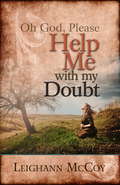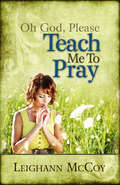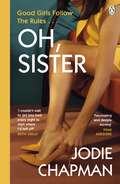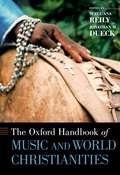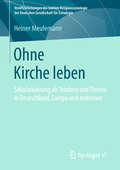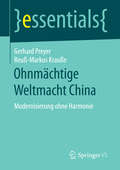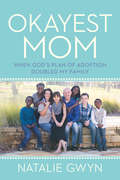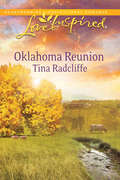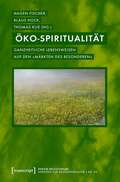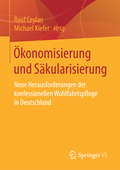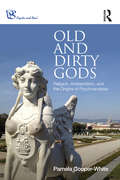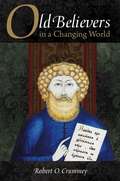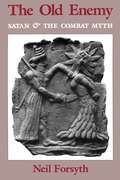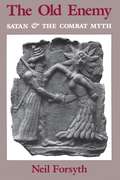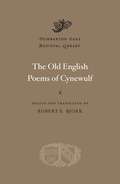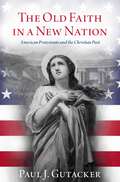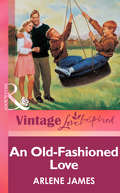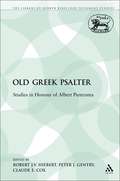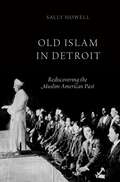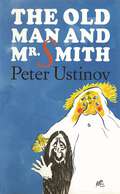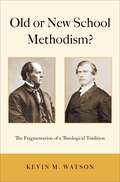- Table View
- List View
Oh God, Please: Help Me With My Doubt
by Leighann McCoyReaders of these books will learn to approach God in honesty through prayer, how to hear His voice through scripture, and be encouraged by examples from the Bible so that she can deal with her own "voices".
Oh God, Please: Teach Me to Pray
by Leighann McCoyReaders of these books will learn to approach God in honesty through prayer, how to hear His voice through scripture, and be encouraged by examples from the Bible so that she can deal with her own "voices".
Oh, Sister: The powerful new novel from the author of Another Life
by Jodie ChapmanTHE STUNNING NEW NOVEL FROM AUTHOR OF BBC2 BETWEEN THE COVERS PICK, ANOTHER LIFEThree women. Three lives. One chance to find themselves . . .'The characters are brought to life in a way that will leave you rooting for them. A touching tale about female friendship [and] finding strength when you need it most' GRAZIA'Distinct and so movingly told that as a reader you really root for them to thrive' GOOD HOUSEKEEPING'Brilliant. A powerful eye-opening read that will spark discussion - a perfect book-club pick' PRIMA 'BOOK OF THE MONTH'____________Meet Isobel, Jen and Zelda.Three women whose bodies and minds are not their own.They belong to the Church.Life and death decisions are taken by others on their behalf.Who they might marry.Whether they start a family.Isobel and Jen know nothing of the world.But when Isobel's husband leaves her and Jen challenges those in charge, the Church turns its back on them.Zelda - never one for doing what is expected - dares to find hope on the outside.Meet Isobel, Jen and Zelda.Three women desperate to find a life to call their own . . .This is a novel about what it is like to live inside a prison of the mind and how to break out of it - if you can.____________Praise for Jodie Chapman:'Beautifully written...I couldn't put it down' EMMA GANNON'An astounding debut about sibling grief, religion and sliding doors love' PANDORA SYKES'Deep, rich, thoughtful' GILLIAN MCALLISTER'This beautiful tale of love, loss and sacrifice will break your heart . . . With echoes of David Nicholls' One Day and Sally Rooney's novels, it perfectly captures the agony of falling in love and the razor-sharp reality of pain and loss' DAILY MAIL
OHB MUSIC & WORLD CHRISTIAN OHBK C (Oxford Handbooks)
by Suzel Ana Reily and Jonathan M. DueckThe Oxford Handbook of Music and World Christianities investigates music's role in everyday practice and social history across the diversity of Christian religions and practices around the globe. The volume explores Christian communities in the Americas, Europe, Africa, Asia, and Australia as sites of transmission, transformation, and creation of deeply diverse musical traditions. The book's contributors, while mostly rooted in ethnomusicology, examine Christianities and their musics in methodologically diverse ways, engaging with musical sound and structure, musical and social history, and ethnography of music and musical performance. These broad materials explore five themes: music and missions, music and religious utopias (and other oppositional religious communities), music and conflict, music and transnational flows, and music and everyday life. The volume as a whole, then, approaches Christian groups and their musics as diverse and powerful windows into the way in which music, religious ideas, capital, and power circulate (and change) between places, now and historically. It also tries to take account of the religious self-understandings of these groups, presenting Christian musical practice and exchange as encompassing and negotiating deeply felt and deeply rooted moral and cultural values. Given that the centerpiece of the volume is Christian religious musical practice, the volume reveals the active role music plays in maintaining and changing religious, moral, and cultural values in a long history of intercultural and transnational encounters.
Ohne Kirche leben: Säkularisierung als Tendenz und Theorie in Deutschland, Europa und anderswo (Veröffentlichungen der Sektion Religionssoziologie der Deutschen Gesellschaft für Soziologie)
by Heiner MeulemannDas Buch befasst sich mit der Säkularisierung in Deutschland, Europa und in ausgewählten Ländern außerhalb Europas seit 1950. Die Säkularisierung wird möglich, wenn nicht nur Eliten, sondern die breite Bevölkerung ohne Kirche leben können, und muss daher mit wiederholten nationalen Bevölkerungsbefragungen in mehreren Ländern erfasst werden. Sie wird ausgelöst durch den Autoritätsverlust der Kirchen, der daran erkennbar wird, dass sie das Monopol an der Begleitung biographischer Übergänge an den Staat verlieren. Sie äußert sich in allen Dimensionen der Religiosität: in der täglichen und außeralltäglichen Praxis, also Kirchgang und Gebet sowie Taufen, Hochzeiten und Beerdigungen, im Glauben und in der diffusen, also nicht kirchlich geprägten, sondern selbstzugeschriebenen Religiosität. Die Theorie der Säkularisierung erklärt diese Tendenzen durch soziale Differenzierung und kulturelle Pluralisierung. Sie wurde selten geprüft, aber meistens bestätigt.
Ohnmächtige Weltmacht China: Modernisierung ohne Harmonie (essentials)
by Gerhard Preyer Reuß-Markus KraußeGerhard Preyer und Reuß-Markus Krauße geben einen Einblick in die chinesische Modernisierung und ihren selbstreferenziellen kulturellen Hintergrund seit den 1990er Jahren. Ihr essential skizziert einen Ausblick auf die Probleme ihrer anstehenden Fortführung. Gegenüber verbreiteten Einschätzungen der Rolle Chinas als einer zukünftigen Weltmacht wird dahin gehend argumentiert, dass China aufgrund seiner veränderten Sozialstruktur eine ohnmächtige Weltmacht sein wird. Das führt zu der grundlegenden Fragestellung, welche nicht-westlichen Problemlösungen nach dem chinesischen Wirtschaftswunder zu erwarten sind. Das betrifft auch ihre Auswirkung auf die chinesische Außenpolitik. Das essential gibt eine Hilfestellung für die Einschätzung der Folgeprobleme der weiteren Modernisierung der chinesischen Gesellschaft und für ihre Beobachtung.
Okayest Mom: When God's Plan of Adoption Doubled My Family
by Natalie GwynNatalie Gwyn uses humor to brilliantly capture how God led and helped this mother of two to adopt four children from Ethiopia and successfully bond her blended family.A happy, working wife, already birth mother of two healthy young children -- a boy and a girl -- doubled the size of her family by adopting four Ethiopian children. Why?Her answer: "God."Popular blogger Natalie Gwyn has been cited widely for her candid, insightful, often humorous writing on cross-cultural adoptive Christian families (which number more than 4 million). HuffPo has linked to her controversial posts and celebrities like Kathie Lee Gifford have quoted and pictured her on social media. Here Natalie tells her whole mom story, including the only-God-could-do-this backstory.Her lighthearted narrative begins with the nudge of God toward the uncomfortable. She and her husband are almost certain they have misunderstood what the Almighty is asking of them, and with self-deprecating humor Natalie allows readers a glimpse into the process by which this already imperfect mom agreed to transnational, transracial adoption of more children than she already has.Natalie then takes the reader on her family's adventure to Ethiopia to legally adopt the three siblings God has chosen to add to their family. With the skill of a detective novelist, she reveals their discovery of a fourth sibling, their critical decision not to leave this child behind, and their harrowing quest to find, woo and legally adopt her, too.Similar to the laugh-out-loud humor of books on blended step-families, Natalie shares the bedroom, bathroom and kitchen scenes of this adoptive family's huge adjustments. She brilliantly captures each child's and each parent's perspective and, in doing so, reveals God in their midst.
Oklahoma Reunion (Mills And Boon Love Inspired Ser.)
by Tina RadcliffeFacing Her Past Single mother Kait Field is back home in the small Oklahoma town she left eight years ago. It’s time to empty the family home, close the door on the past and introduce her daughter, Jenna, to her daddy. Ryan Jones hasn’t quite forgiven his teenage sweetheart, who left him with unanswered questions and a broken heart.
Öko-Spiritualität: Ganzheitliche Lebensweisen auf den »Märkten des Besonderen« (rerum religionum. Arbeiten zur Religionskultur #4)
by Hagen Fischer Klaus Hock Thomas KlieAuf dem wachsenden Markt ökologisch produzierter Lebensmittel ist bei einigen Produzierenden, Konsumierenden und Verbänden zunehmend ein ganzheitlicher Anspruch feststellbar. Dieser Trend holistischen Charakters wird durch Angebote alternativer Heilverfahren einiger Bio-Bauernhöfe noch unterstrichen. So warten Akteure neben der Vermarktung ihrer Erzeugnisse mit zusätzlichen Produkten und Dienstleistungen auf, die in ein übergreifendes, ganzheitliches Lebenskonzept eingebettet sind: ökologisch, gesund, sozial, fair, regional, nachhaltig, gemeinschaftsfördernd, spirituell. Die Beiträge des Bandes befassen sich mit dieser ökologisch orientierten Landwirtschaft, die zum Referenzfeld religiös markierter Praktiken wird.
Ökonomisierung und Säkularisierung: Neue Herausforderungen der konfessionellen Wohlfahrtspflege in Deutschland
by Rauf Ceylan Michael KieferKonfessionelle Wohlfahrtsorganisationen haben sich im Zuge der Einführung eines modernen Sozialstaates zu einer wichtigen Säule des gesellschaftlichen Zusammenhalts entwickelt. Allerdings werden sie infolge der Prozesse Globalisierung, Migration, Säkularisierung, Pluralisierung und Rationalisierung gegenwärtig vor neue Herausforderungen gestellt. Der Gedanke der interkonfessionellen Zusammenarbeit und die Schaffung eines gemeinsamen Diskursfeldes bilden den Hintergrund für diesen Band. In fünf Themenschwerpunkten diskutieren Expertinnen und Experten aus dem Bereich Wohlfahrtspflege/-verbände historische, gegenwartsbezogene sowie zukünftige Entwicklungen und Herausforderungen.
Old and Dirty Gods: Religion, Antisemitism, and the Origins of Psychoanalysis (Psyche and Soul)
by Pamela Cooper-WhiteFreud’s collection of antiquities—his "old and dirty gods"—stood as silent witnesses to the early analysts’ paradoxical fascination and hostility toward religion. Pamela Cooper-White argues that antisemitism, reaching back centuries before the Holocaust, and the acute perspective from the margins that it engendered among the first analysts, stands at the very origins of psychoanalytic theory and practice. The core insight of psychoanalytic thought— that there is always more beneath the surface appearances of reality, and that this "more" is among other things affective, memory-laden and psychological—cannot fail to have had something to do with the experiences of the first Jewish analysts in their position of marginality and oppression in Habsburg-Catholic Vienna of the 20th century. The book concludes with some parallels between the decades leading to the Holocaust and the current political situation in the U.S. and Europe, and their implications for psychoanalytic practice today. Covering Pfister, Reik, Rank, and Spielrein as well as Freud, Cooper-White sets out how the first analysts’ position as Europe’s religious and racial "Other" shaped the development of psychoanalysis, and how these tensions continue to affect psychoanalysis today. Old and Dirty Gods will be of great interest to psychoanalysts as well as religious studies scholars.
Old and Dirty Gods: Religion, Antisemitism, and the Origins of Psychoanalysis (Psyche and Soul)
by Pamela Cooper-WhiteFreud’s collection of antiquities—his "old and dirty gods"—stood as silent witnesses to the early analysts’ paradoxical fascination and hostility toward religion. Pamela Cooper-White argues that antisemitism, reaching back centuries before the Holocaust, and the acute perspective from the margins that it engendered among the first analysts, stands at the very origins of psychoanalytic theory and practice. The core insight of psychoanalytic thought— that there is always more beneath the surface appearances of reality, and that this "more" is among other things affective, memory-laden and psychological—cannot fail to have had something to do with the experiences of the first Jewish analysts in their position of marginality and oppression in Habsburg-Catholic Vienna of the 20th century. The book concludes with some parallels between the decades leading to the Holocaust and the current political situation in the U.S. and Europe, and their implications for psychoanalytic practice today. Covering Pfister, Reik, Rank, and Spielrein as well as Freud, Cooper-White sets out how the first analysts’ position as Europe’s religious and racial "Other" shaped the development of psychoanalysis, and how these tensions continue to affect psychoanalysis today. Old and Dirty Gods will be of great interest to psychoanalysts as well as religious studies scholars.
Old Believers in a Changing World (NIU Series in Orthodox Christian Studies)
by Robert CrummeyThis important collection of essays by a pioneer in the field focuses on the history and culture of a conservative religious tradition whose adherents have fought to preserve their beliefs and practices from the seventeenth century through today. Old Belief had its origins in a protest against liturgical reforms in the Russian Orthodox Church in the mid-1600s and quickly grew into a complex torrent of opposition to the Russian state, the official church, and the social hierarchy. For Old Believers, periods of full religious freedom have been very brief—from 1905 to 1917 and since the fall of the Soviet Union. Crummey examines the ways in which Old Believers defend their core beliefs and practices and adjust their polemical strategies and way of life in response to the changing world. Opening chapters survey the historiography of Old Belief, examine the methodological problems in studying the movement as a Russian example of "popular religion," and outline the first decades of the history. Particular themes of Old Believer history are the focus of the rest of the book, beginning with two sets of case studies of spirituality, culture, and intellectual life. Subsequent chapters analyze the diverse structures of Old Believer communities and their fate in times of persecution. A final essay examines publications of contemporary scholars in Novosibirsk whose work provides glimpses of the life of traditional believers in the Soviet period. Old Believers in a Changing World will appeal to scholars and students of Russian history, to those interested in Eastern Orthodoxy, and to those with an interest in the comparative history of religious movements.
The Old Enemy: Satan and the Combat Myth
by Neil ForsythThe description for this book, The Old Enemy: Satan and the Combat Myth, will be forthcoming.
The Old Enemy: Satan and the Combat Myth
by Neil ForsythThe description for this book, The Old Enemy: Satan and the Combat Myth, will be forthcoming.
The Old English Poems Of Cynewulf (Dumbarton Oaks Medieval Library #23)
by Cynewulf Cynewulf Robert E. BjorkThe Old English poems attributed to Cynewulf, who flourished some time between the eighth and tenth centuries, are unusual because most vernacular poems in this period are anonymous. Other than the name, we have no biographical details of Cynewulf, not even the most basic facts of where or when he lived. Yet the poems themselves attest to a powerfully inventive imagination, deeply learned in Christian doctrine and traditional verse-craft. Runic letters spelling out the name Cynewulf appear in four poems: Christ II (or The Ascension), Juliana, The Fates of the Apostles, and Elene. To these a fifth can be added, Guthlac B because of similarities in style and vocabulary, but any signature (if one ever existed) has been lost because its ending lines are missing. What characterizes Cynewulf's poetry? He reveals an expert control of structure as shown from the changes he makes to his Latin sources. He has a flair for extended similes and dramatic dialogue. In Christ II, for example, the major events in Christ's life are portrayed as vigorous leaps. In Juliana the force of the saint's rhetoric utterly confounds a demon sent to torment her.
The Old Faith in a New Nation: American Protestants and the Christian Past
by Paul J. GutackerConventional wisdom holds that tradition and history meant little to nineteenth-century American Protestants, who relied on common sense and "the Bible alone." The Old Faith in a New Nation challenges this portrayal by recovering evangelical engagement with the Christian past. Even when they appeared to be most scornful toward tradition, most optimistic and forward-looking, and most confident in their grasp of the Bible, evangelicals found themselves returning, time and again, to Christian history. They studied religious historiography, reinterpreted the history of the church, and argued over its implications for the present. Between the Revolution and the Civil War, American Protestants were deeply interested in the meaning of the Christian past. Paul J. Gutacker draws from hundreds of print sources-sermons, books, speeches, legal arguments, political petitions, and more-to show how ordinary educated Americans remembered and used Christian history. While claiming to rely on the Bible alone, antebellum Protestants frequently turned to the Christian past on questions of import: how should the government relate to religion? Could Catholic immigrants become true Americans? What opportunities and rights should be available to women? To African Americans? Protestants across denominations answered these questions not only with the Bible but also with history. By recovering the ways in which American evangelicals remembered and used Christian history, The Old Faith in a New Nation shows how religious memory shaped the nation and interrogates the meaning of "biblicism."
The Old Faith in a New Nation: American Protestants and the Christian Past
by Paul J. GutackerConventional wisdom holds that tradition and history meant little to nineteenth-century American Protestants, who relied on common sense and "the Bible alone." The Old Faith in a New Nation challenges this portrayal by recovering evangelical engagement with the Christian past. Even when they appeared to be most scornful toward tradition, most optimistic and forward-looking, and most confident in their grasp of the Bible, evangelicals found themselves returning, time and again, to Christian history. They studied religious historiography, reinterpreted the history of the church, and argued over its implications for the present. Between the Revolution and the Civil War, American Protestants were deeply interested in the meaning of the Christian past. Paul J. Gutacker draws from hundreds of print sources-sermons, books, speeches, legal arguments, political petitions, and more-to show how ordinary educated Americans remembered and used Christian history. While claiming to rely on the Bible alone, antebellum Protestants frequently turned to the Christian past on questions of import: how should the government relate to religion? Could Catholic immigrants become true Americans? What opportunities and rights should be available to women? To African Americans? Protestants across denominations answered these questions not only with the Bible but also with history. By recovering the ways in which American evangelicals remembered and used Christian history, The Old Faith in a New Nation shows how religious memory shaped the nation and interrogates the meaning of "biblicism."
An Old-Fashioned Love (Mills And Boon Vintage Love Inspired Ser. #2)
by Arlene JamesEVERYDAY MIRACLES TRIPLE TROUBLE!
The Old Greek Psalter: Studies in Honour of Albert Pietersma (The Library of Hebrew Bible/Old Testament Studies)
by Robert J.V. Hiebert Claude E. Cox Peter J. GentryThis tribute to Albert Pietersma of the University of Toronto is offered by a highly distinguished international panel of scholars, including John W. Wevers, Takamitsu Muraoka, Anneli Aejmelaeus, Emanuel Tov, Johan Lust, Robert A. Kraft, Johann Cook, Arie van der Kooij, Moises Silva and Claude E. Cox. The focus of the volume is on the Old Greek Psalter and its significance for biblical research and related disciplines, where it marks a definitive statement of research questions and issues in this increasingly important area of biblical textual studies.
Old Islam in Detroit: Rediscovering the Muslim American Past
by Sally HowellAcross North America, Islam is portrayed as a religion of immigrants, converts, and cultural outsiders. Yet Muslims have been part of American society for much longer than most people realize. This book documents the history of Islam in Detroit, a city that is home to several of the nation's oldest, most diverse Muslim communities. In the early 1900s, there were thousands of Muslims in Detroit. Most came from Eastern Europe, the Ottoman Empire, and British India. In 1921, they built the nation's first mosque in Highland Park. By the 1930s, new Islam-oriented social movements were taking root among African Americans in Detroit. By the 1950s, Albanians, Arabs, African Americans, and South Asians all had mosques and religious associations in the city, and they were confident that Islam could be, and had already become, an American religion. When immigration laws were liberalized in 1965, new immigrants and new African American converts rapidly became the majority of U.S. Muslims. For them, Detroit's old Muslims and their mosques seemed oddly Americanized, even unorthodox. Old Islam in Detroit explores the rise of Detroit's earliest Muslim communities. It documents the culture wars and doctrinal debates that ensued as these populations confronted Muslim newcomers who did not understand their manner of worship or the American identities they had created. Looking closely at this historical encounter, Old Islam in Detroit provides a new interpretation of the possibilities and limits of Muslim incorporation in American life. It shows how Islam has become American in the past and how the anxieties many new Muslim Americans and non-Muslims feel about the place of Islam in American society today are not inevitable, but are part of a dynamic process of political and religious change that is still unfolding.
Old Islam in Detroit: Rediscovering the Muslim American Past
by Sally HowellAcross North America, Islam is portrayed as a religion of immigrants, converts, and cultural outsiders. Yet Muslims have been part of American society for much longer than most people realize. This book documents the history of Islam in Detroit, a city that is home to several of the nation's oldest, most diverse Muslim communities. In the early 1900s, there were thousands of Muslims in Detroit. Most came from Eastern Europe, the Ottoman Empire, and British India. In 1921, they built the nation's first mosque in Highland Park. By the 1930s, new Islam-oriented social movements were taking root among African Americans in Detroit. By the 1950s, Albanians, Arabs, African Americans, and South Asians all had mosques and religious associations in the city, and they were confident that Islam could be, and had already become, an American religion. When immigration laws were liberalized in 1965, new immigrants and new African American converts rapidly became the majority of U.S. Muslims. For them, Detroit's old Muslims and their mosques seemed oddly Americanized, even unorthodox. Old Islam in Detroit explores the rise of Detroit's earliest Muslim communities. It documents the culture wars and doctrinal debates that ensued as these populations confronted Muslim newcomers who did not understand their manner of worship or the American identities they had created. Looking closely at this historical encounter, Old Islam in Detroit provides a new interpretation of the possibilities and limits of Muslim incorporation in American life. It shows how Islam has become American in the past and how the anxieties many new Muslim Americans and non-Muslims feel about the place of Islam in American society today are not inevitable, but are part of a dynamic process of political and religious change that is still unfolding.
The Old Man and Mr. Smith
by Peter UstinovFrom the late and great Peter Ustinov comes a story full of wit, satire and insight.An increasingly decrepit God and a merely ill-tempered Satan are reconciled and attempt a mission to Earth, where their misadventures point up the comedy and tragedy of modern life, as they travel to a variety of countries in the guise of the Old Man (God) and Mr. Smith (Satan), with the FBI and Interpol in hot pursuit.
Old or New School Methodism?: The Fragmentation of a Theological Tradition
by Kevin M. WatsonOn September 7, 1881, Matthew Simpson, Bishop in the Methodist Episcopal Church, in a London sermon asserted that, "As to the divisions in the Methodist family, there is little to mar the family likeness." Nearly a quarter-century earlier, Benjamin Titus (B.T.) Roberts, a minister in the same branch of Methodism as Simpson, had published an article titled in the Northern Independent in which he argued that Methodism had split into an "Old School" and "New School." He warned that if the new school were to "generally prevail," then "the glory will depart from Methodism." As a result, Roberts was charged with "unchristian and immoral conduct" and expelled from the Genesee Conference of the Methodist Episcopal Church (MEC). Old or New School Methodism? examines how less than three decades later Matthew Simpson could claim that the basic beliefs and practices that Roberts had seen as threatened were in fact a source of persisting unity across all branches of Methodism. Kevin M. Watson argues that B. T. Roberts's expulsion from the MEC and the subsequent formation of the Free Methodist Church represent a crucial moment of transition in American Methodism. This book challenges understandings of American Methodism that emphasize its breadth and openness to a variety of theological commitments and underemphasize the particular theological commitments that have made it distinctive and have been the cause of divisions over the past century and a half. Old or New School Methodism? fills a major gap in the study of American Methodism from the 1850s to 1950s through a detailed study of two of the key figures of the period and their influence on the denomination.
